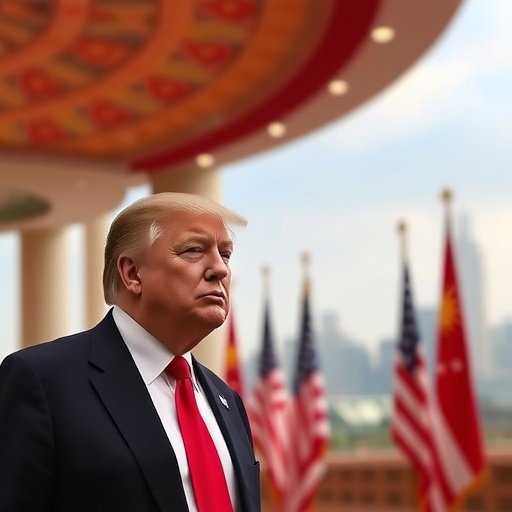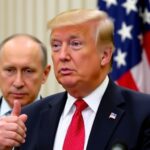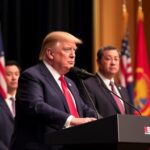Trump Returns to Kuala Lumpur for ASEAN Summit: Reinforcing US Indo-Pacific Strategy Amid Trade Tensions
In a bold move signaling America’s renewed commitment to the Asia-Pacific, President Donald Trump touched down in Kuala Lumpur on Monday for his first ASEAN Summit appearance since 2017, aiming to counterbalance China’s growing influence while positioning himself as the ultimate global dealmaker. This high-stakes visit comes at a pivotal moment, with escalating trade disputes and regional security flashpoints threatening stability in the Indo-Pacific.
Trump‘s arrival at the Kuala Lumpur International Airport was met with a mix of anticipation and scrutiny from Southeast Asian leaders, who see the U.S. president’s presence as a potential lifeline against economic pressures from Beijing. The summit, hosted by Malaysia as the 2025 chair of the Association of Southeast Asian Nations (ASEAN), gathers heads of state from 10 member countries to discuss everything from supply chain resilience to maritime security. For Trump, it’s an opportunity to tout his US foreign policy vision, emphasizing bilateral deals over multilateral entanglements.
Trump’s High-Profile Arrival Sparks Regional Optimism
The buzz around Trump‘s return to the ASEAN Summit was palpable as his motorcade rolled through the bustling streets of Kuala Lumpur, flanked by Secret Service agents and a delegation of top trade advisors. Malaysian Prime Minister Anwar Ibrahim welcomed Trump with a ceremonial handshake at the summit venue, the opulent Putra World Trade Centre, where banners proclaiming “Unity in Diversity” fluttered in the humid tropical air.
“President Trump’s decision to prioritize this summit underscores the enduring partnership between the United States and ASEAN nations,” Anwar said in his opening remarks. “In an era of uncertainty, his leadership can pave the way for fair trade and shared prosperity.” This sentiment echoed across the region, where U.S. investment in Southeast Asia has surged by 25% since Trump’s inauguration, according to U.S. Commerce Department data released last week.
Historically, Trump’s 2017 visit to the Philippines for the ASEAN summit marked a contentious debut, overshadowed by his abrupt exit from the Trans-Pacific Partnership (TPP) and sharp rhetoric toward North Korea. Fast forward to 2025, and the landscape has shifted dramatically. With U.S. exports to ASEAN countries topping $350 billion annually—up from $280 billion in 2016—the stakes are higher. Analysts point to Trump’s “America First” doctrine evolving into a more nuanced Indo-Pacific strategy, one that leverages tariffs on Chinese goods to draw ASEAN economies closer to Washington.
During a brief press gaggle upon arrival, Trump quipped, “We’re here to make great deals, folks. China thinks they own this neighborhood, but America’s back, and we’re building alliances that last.” His words resonated with business leaders in attendance, including CEOs from tech giants like Qualcomm and Intel, who are eyeing expanded manufacturing hubs in Vietnam and Indonesia to diversify away from China.
Trade Negotiations Heat Up as US Counters China’s Influence
At the heart of the ASEAN Summit discussions is the thorny issue of trade, where Trump‘s tariff policies are both a weapon and a bargaining chip. The U.S. has imposed duties on over $500 billion in Chinese imports since 2018, prompting ASEAN nations to navigate a delicate balance. Countries like Vietnam have seen a 40% boom in exports to the U.S., filling the void left by Beijing’s slowdown, per World Bank reports.
Trump’s agenda includes bilateral talks with key players: a one-on-one with Indonesian President Prabowo Subianto to ink a $10 billion infrastructure deal, and negotiations with Thailand on agricultural exports. “We’re not just talking; we’re doing,” Trump emphasized in a pre-summit briefing. These moves align with the broader US foreign policy pivot toward the Indo-Pacific, where the U.S. views ASEAN as a counterweight to China’s Belt and Road Initiative, which has funneled $1 trillion into regional projects but left some nations saddled with debt.
Experts like Dr. Evelyn Goh from the Australian National University highlight the strategic calculus. “Trump’s approach is transactional, but it’s effective in a region wary of over-reliance on China,” she told reporters. Statistics underscore the shift: U.S. foreign direct investment in ASEAN reached $240 billion in 2024, surpassing China’s $190 billion for the first time in a decade, according to the ASEAN Secretariat.
Yet, challenges abound. Singapore’s Trade Minister Gan Kim Yong voiced concerns over potential U.S. tariffs on electronics, a sector vital to the city-state’s economy. “We seek predictability in US foreign policy,” he noted, urging Trump to extend exemptions under the USMCA framework to ASEAN partners. The summit’s trade plenary session, scheduled for Tuesday, will feature heated debates on digital economy rules, with the U.S. pushing for standards that exclude Huawei technologies.
- Key Trade Stats: U.S.-ASEAN trade volume: $600 billion (2024)
- China-ASEAN trade: $975 billion, but growing at a slower 5% YoY vs. U.S. 8%
- Potential new deals: $50 billion in commitments from U.S. firms
Trump’s dealmaking persona shines here, reminiscent of his North American trade renegotiations. If successful, these pacts could reshape supply chains, reducing global reliance on Chinese manufacturing by 15-20%, as projected by McKinsey Global Institute.
Security Dialogues Intensify Over South China Sea Tensions
Beyond economics, the ASEAN Summit in Kuala Lumpur is a forum for addressing simmering security issues, particularly in the South China Sea, where territorial claims by China have militarized disputed waters. Trump‘s itinerary includes a closed-door session with defense ministers, focusing on freedom of navigation operations and joint military exercises.
The U.S. has ramped up its presence, conducting 10 freedom of navigation patrols in 2024 alone, up from six the previous year, according to Pentagon reports. “Our Indo-Pacific strategy is about peace through strength,” Trump declared, echoing his administration’s Quad alliance with Japan, Australia, and India. ASEAN nations, while neutral on paper, are increasingly aligning with U.S. initiatives; the Philippines, under President Ferdinand Marcos Jr., has granted expanded U.S. access to bases, a move Trump is set to applaud.
Philippine Foreign Secretary Enrique Manalo captured the urgency: “With Chinese vessels encroaching on our exclusive economic zone 300 times last year, we need robust U.S. commitments.” Data from the Asia Maritime Transparency Initiative reveals over 200 Chinese incursions in 2024, heightening fears of escalation.
Trump’s talks with Vietnam’s leader, To Lam, will delve into cybersecurity cooperation, following a series of hacks attributed to state actors. The U.S. is offering $2 billion in military aid to ASEAN partners, including drone technology and intelligence sharing, to bolster defenses without provoking direct confrontation.
Regional analysts warn of ripple effects. “Trump’s assertive US foreign policy could deter aggression but risks alienating moderates in ASEAN,” said Bilahari Kausikan, former Singapore diplomat. The summit’s security track also touches on Myanmar’s civil war, where U.S. sanctions on the junta aim to support democratic forces, drawing mixed reactions from neighbors.
- Flashpoints Addressed: South China Sea disputes involving Brunei, Malaysia, Philippines, Vietnam
- U.S. commitments: Enhanced QUAD-ASEAN linkages
- Potential outcomes: Joint naval drills in 2026
As discussions unfold, Trump’s emphasis on bilateral security pacts over ASEAN-wide treaties reflects his preference for tailored alliances, a departure from the Obama-era multilateralism.
Bilateral Breakthroughs: Spotlight on Key Partnerships
Kuala Lumpur serves as more than a summit backdrop; it’s a hub for side deals that could define U.S.-ASEAN ties for years. Trump’s schedule is packed: a breakfast with Malaysia’s Anwar on semiconductor supply chains, where the U.S. seeks to onshore critical tech amid global chip shortages. Malaysia, home to Intel’s largest assembly plant, stands to gain from $5 billion in U.S. incentives under the CHIPS Act.
Further afield, Trump will host a trilateral with leaders from Cambodia and Laos—nations often in China’s orbit—to discuss Mekong River development. “We’re investing in clean energy, not debt traps,” a White House official previewed, referencing U.S.-backed hydropower projects worth $1.2 billion.
India’s role looms large too, with informal Quad consultations on the sidelines. Prime Minister Narendra Modi’s virtual address will align with Trump’s narrative of a “free and open Indo-Pacific.” Quotes from U.S. Ambassador to ASEAN, Yohannes Abraham, underscore the momentum: “This summit is a reset button, fostering trust through action.”
Business delegations amplify the impact. Over 200 U.S. firms, from Boeing to Pfizer, are scouting opportunities, with projections of 50,000 new jobs in the region. Yet, human rights concerns linger; activists protest Trump’s meeting with Brunei’s Sultan over LGBTQ+ policies, adding a layer of diplomatic tension.
These bilaterals aren’t just photo ops—they’re foundational to Trump’s legacy as a deal architect, potentially unlocking $100 billion in trade flows over the next five years, per U.S. Trade Representative estimates.
Looking Ahead: Trump’s Indo-Pacific Vision Shapes Global Alliances
As the ASEAN Summit progresses, the implications for US foreign policy extend far beyond Kuala Lumpur. Trump’s engagement signals a long-term U.S. reorientation toward the Indo-Pacific, where 60% of global GDP resides. Success here could stabilize supply chains, deter adventurism in the Taiwan Strait, and integrate ASEAN into broader U.S.-led frameworks like the Indo-Pacific Economic Framework (IPEF).
Challenges persist: Domestic U.S. politics, with midterm elections looming, may constrain commitments, while China’s response—possibly through escalated economic coercion—looms. Still, optimists see Trump’s visit as a catalyst. “If he secures even half the deals on the table, it redefines power dynamics,” noted CSIS Asia expert Bonnie Glaser.
Post-summit, Trump plans stops in Hanoi and Manila to deepen ties, hinting at a whirlwind Asia tour. For ASEAN, the message is clear: The U.S. is all in, offering partnership on equal terms. As regional leaders depart Kuala Lumpur, the echoes of Trump’s dealmaking rhetoric will influence boardrooms and battlefields alike, setting the stage for a more multipolar Indo-Pacific.








